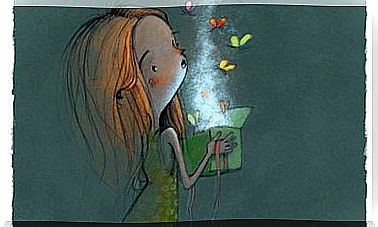Children Need To Vent Their Emotions To Grow Emotionally

” Don’t cry “, ” Big children are strong ” or “You have to be brave ” are very common expressions used by adults to alleviate the suffering and discontent of children. The point is that, despite the fact that at that time with some children they seem to work as short-term measures, in the long run they contribute to not expressing how they feel, and this silence may have serious implications on their psychological and social development. Children need to vent their emotions.
Ignoring or denying children’s emotions is dangerous behavior. Therefore, it is a good idea to avoid it if we want your emotional health and relationships to evolve in a positive way. Not because they are small, your thoughts and emotions are not important. Rather, the opposite is true.
In reality their world is as important as ours, as are their perceptions and feelings, to which we have to give support so that little by little they get to know each other. Let’s delve into the beautiful task of teaching children to understand and vent their emotions.
The Danger of Suppressing Children’s Emotions
Anger, sadness or anger in children are natural responses that can have different origins: from misunderstanding what is happening to frustration at not having achieved what they wanted or a simple tantrum. In one way or another, all these emotions carry a message – beyond discomfort – that needs to be understood and released.
Now, if instead of translating the tears, screams or discomfort of our children to deepen what happens to them, we dedicate ourselves to rejecting their emotions or not giving them importance, we will help them to express them to us . In addition, we will also be rejecting their identity and demanding behavior – ideal for us – based on fear and the denial of their emotions.

If we repress the emotions of our children, they will become adults unable to handle emotional language, both with themselves and with others, thus limiting their well-being. The development of emotional intelligence will also be hampered because, as the psychologist Daniel Goleman affirms, the knowledge of oneself and of one’s own feelings is the cornerstone of emotional intelligence: the foundation on which personal growth is based.
Emotional relief in children
We have little practice in educating children to identify, express and air their emotions, especially those considered negative such as rage, anger or sadness. We even think that if they express these types of emotions they are rude, rude or aggressive. The point is that if we don’t teach them to connect with their emotional world, they will never understand themselves or manage how they feel.
Thus, if we want to educate emotionally intelligent children to contribute positively to their emotional health, we have to start by allowing them to release their emotions. Otherwise, the discomfort will invade them little by little until it expresses itself in another way, becoming prisoners of their emotions.
Venting anger or a feeling of sadness relieves, heals, and helps you to continue and understand yourself. That is why it is so necessary. Furthermore, if children learn to vent their emotions from the earliest years, they will become emotionally healthy adults. Investing in emotional education for the little ones is investing in the future of adults, let’s not forget it.
How to help children vent their emotions?
There are many ways for children to express how they feel as well as to channel their negative emotions, from crying to the process of identifying their feelings step by step.
The important thing is to be aware that this is one more need for them and that we cannot respond through anger, criticism, lack of control or threats. If we are not their support and support in a situation of discomfort, they will hardly be able to take care of themselves, especially during the first years. Thus, a child needs a calm environment around him and not people who feed his anger.
Our attitude with him has to start from affection, listening and empathy to help him identify how he feels, what are the causes that have produced those feelings and how he can do to release his emotions. In addition, in this way we will gradually promote their emotional regulation capacity.

One thing to avoid, when children are angry or their emotions overwhelm them, is to try to reason with them immediately. We can suggest that they express how they feel to unblock the discomfort, but often waiting a few minutes will promote their calm.
From that moment is when the dialogue will be much more fluid and we can encourage them to express everything they think and need as a relief. In addition, it is important that we make them understand that, when they express themselves, they acquire the opportunity to think better and act more appropriately. The rule to follow will be not to offend or harm others.
The traffic light technique
A widely used technique for children to learn to regulate and vent their emotions is the traffic light technique. The goal is for children to associate the colors of a traffic light with their emotions and behaviors. To do this, we can draw a traffic light and explain something like this:
- Red color. This color would be associated with stopping. Thus, when they feel very angry, get nervous or want to yell and fight, they should remember that the red light of the traffic light comes on and they have to stop. It is as if they were the driver of a car that meets a red light. The message we can convey to you is: Stop! Calm down and think.
- Yellow color. This color signals the time to stop and think to find out what the problem is and what they are feeling. We can tell you that when the traffic light is yellow, drivers stop, think, look for solutions and prepare to leave. In this case we would say: Think solutions and their consequences.
- Green color. This color is the indication to continue, that is, to choose the best solution and start it. The message that helps them in these cases would be: Go ahead and put the best solution into practice.
Another technique that usually works to vent their discomfort is asking them to draw their anger, so that later they can tell you everything they need and finally break it (a symbolic way to end it, once they have heard your message). They can also count to 10, walk away, or take a deep breath. Then, we will reflect with them on the causes that have led them to feel this way, how they can channel it and what ways there are to solve what happened. The latter will foster your emotional awareness, regulation, and responsibility.

As we can see, children can express and air their negative emotions, what happens is that most of the time they do not know how to do it. The important thing is that we help them express them through an emotional and positive education, based on understanding and affection.









